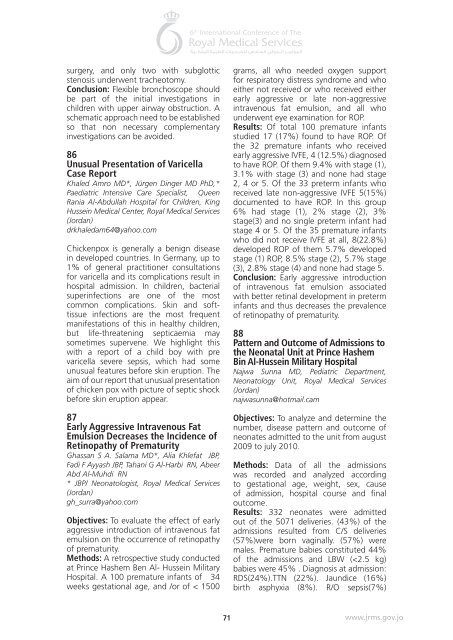Abstract book 6th RMS 16.indd
Abstract book 6th RMS 16.indd
Abstract book 6th RMS 16.indd
You also want an ePaper? Increase the reach of your titles
YUMPU automatically turns print PDFs into web optimized ePapers that Google loves.
surgery, and only two with subglottic<br />
stenosis underwent tracheotomy.<br />
Conclusion: Flexible bronchoscope should<br />
be part of the initial investigations in<br />
children with upper airway obstruction. A<br />
schematic approach need to be established<br />
so that non necessary complementary<br />
investigations can be avoided.<br />
86<br />
Unusual Presentation of Varicella<br />
Case Report<br />
Khaled Amro MD*, Jürgen Dinger MD PhD,*<br />
Paediatric Intensive Care Specialist, Queen<br />
Rania Al-Abdullah Hospital for Children, King<br />
Hussein Medical Center, Royal Medical Services<br />
(Jordan)<br />
drkhaledam64@yahoo.com<br />
Chickenpox is generally a benign disease<br />
in developed countries. In Germany, up to<br />
1% of general practitioner consultations<br />
for varicella and its complications result in<br />
hospital admission. In children, bacterial<br />
superinfections are one of the most<br />
common complications. Skin and softtissue<br />
infections are the most frequent<br />
manifestations of this in healthy children,<br />
but life-threatening septicaemia may<br />
sometimes supervene. We highlight this<br />
with a report of a child boy with pre<br />
varicella severe sepsis, which had some<br />
unusual features before skin eruption. The<br />
aim of our report that unusual presentation<br />
of chicken pox with picture of septic shock<br />
before skin eruption appear.<br />
87<br />
Early Aggressive Intravenous Fat<br />
Emulsion Decreases the Incidence of<br />
Retinopathy of Prematurity<br />
Ghassan S A. Salama MD*, Alia Khlefat JBP,<br />
Fadi F Ayyash JBP, Tahani G Al-Harbi RN, Abeer<br />
Abd Al-Muhdi RN<br />
* JBP/ Neonatologist, Royal Medical Services<br />
(Jordan)<br />
gh_surra@yahoo.com<br />
Objectives: To evaluate the effect of early<br />
aggressive introduction of intravenous fat<br />
emulsion on the occurrence of retinopathy<br />
of prematurity.<br />
Methods: A retrospective study conducted<br />
at Prince Hashem Ben Al- Hussein Military<br />
Hospital. A 100 premature infants of ≤ 34<br />
weeks gestational age, and /or of < 1500<br />
grams, all who needed oxygen support<br />
for respiratory distress syndrome and who<br />
either not received or who received either<br />
early aggressive or late non-aggressive<br />
intravenous fat emulsion, and all who<br />
underwent eye examination for ROP.<br />
Results: Of total 100 premature infants<br />
studied 17 (17%) found to have ROP. Of<br />
the 32 premature infants who received<br />
early aggressive IVFE, 4 (12.5%) diagnosed<br />
to have ROP. Of them 9.4% with stage (1),<br />
3.1% with stage (3) and none had stage<br />
2, 4 or 5. Of the 33 preterm infants who<br />
received late non-aggressive IVFE 5(15%)<br />
documented to have ROP. In this group<br />
6% had stage (1), 2% stage (2), 3%<br />
stage(3) and no single preterm infant had<br />
stage 4 or 5. Of the 35 premature infants<br />
who did not receive IVFE at all, 8(22.8%)<br />
developed ROP of them 5.7% developed<br />
stage (1) ROP, 8.5% stage (2), 5.7% stage<br />
(3), 2.8% stage (4) and none had stage 5.<br />
Conclusion: Early aggressive introduction<br />
of intravenous fat emulsion associated<br />
with better retinal development in preterm<br />
infants and thus decreases the prevalence<br />
of retinopathy of prematurity.<br />
88<br />
Pattern and Outcome of Admissions to<br />
the Neonatal Unit at Prince Hashem<br />
Bin Al-Hussein Military Hospital<br />
Najwa Sunna MD, Pediatric Department,<br />
Neonatology Unit, Royal Medical Services<br />
(Jordan)<br />
najwasunna@hotmail.cam<br />
Objectives: To analyze and determine the<br />
number, disease pattern and outcome of<br />
neonates admitted to the unit from august<br />
2009 to july 2010.<br />
Methods: Data of all the admissions<br />
was recorded and analyzed according<br />
to gestational age, weight, sex, cause<br />
of admission, hospital course and final<br />
outcome.<br />
Results: 332 neonates were admitted<br />
out of the 5071 deliveries. (43%) of the<br />
admissions resulted from C/S deliveries<br />
(57%)were born vaginally. (57%) were<br />
males. Premature babies constituted 44%<br />
of the admissions and LBW (

















